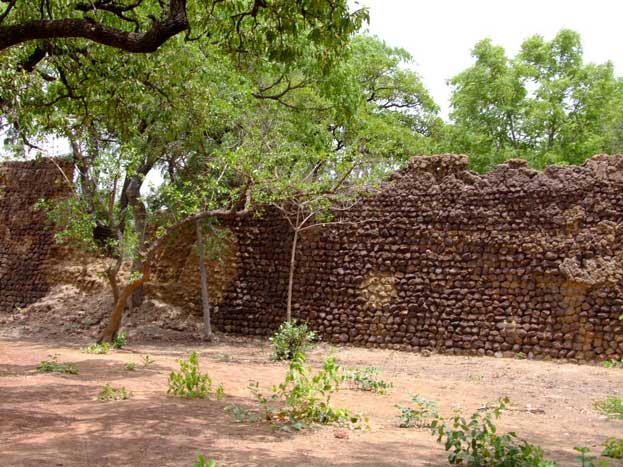The recent inter-disciplinary project has allowed a reassessment of the history of Loropeni. This has pushed much further back the date of its construction from around the 17th century to at least the 11th century AD and disassociated it from the Gan people, mentioned in the previous evaluation report. Indeed in spite of the many writings on these ruins since the beginning of the 20th century, no serious archaeological investigations have been undertaken to support information from oral traditions and the other documentary sources. The recent targeted excavations were to thus able to start to bridge this gap.

Continent: Africa
Country: Burkina
Category: Cultural
Criterion: (III)
Date of Inscription: 2009
Loropeni ruins
It is necessary to locate the construction of the Loropeni ruins in the geopolitical context of the sub-Saharan kingdoms. They appeared after the fall of the first empires of Ghana, Mali, and Songhai, when there were migrations of gold miners and goldsmiths into the Lobi area, and well before the development to the south of the Akan kingdoms, such as the powerful Ashanti kingdom, which caused migrations to the north as people fled slave hunters. Around Lobi country are the remains of many gold mines such as Werimitangna, close to Loropeni.The gold bearing region was connected by caravans to the large commercial cites to the north on the river Niger, such as Djenne, Mopti and Timbuktu and from there across the Sahara to north Africa., It was probably later that the gold was traded south to the Atlantic coast. Lobi country is crossed by the north-south Mopti - Sore-Dioulasso - Kong route, and the east-southwest route from Ouagadougou, through Boromo, Diebougou, Gaoua, to Bondoukou.
 |
| Ruins of Loropeni Burkina |
Browse Gallery Plus UNESCO Storyline
The ruins have long been associated with the gold trade but the evidence for this is circumstantial. It is suggested that such large and fortified structures need to be associated with defending a high value product and the need to house labour. The southern enclose could have been used for slaves or miners at the gold mines. However no direct evidence for gold or for the use of the southern enclosure was forthcoming from the recent excavations.
Most oral traditions collected since the "discovery" of the ruins in 1902 indicate the Koulango people as builders of fortresses in the area, as well as in Burkina Faso in Ivory Coast. However, the most recent research shows that the Koulango were preceded by Lorhon and Nabe peoples who migrated south into the area and were known to be in the area of Kong, from the 10th century.
The Gan, who have been attributed as being the builders of the ruins, simply re-used them from the end of the 17th century when they left the territory of current Ghana to escape oppression from the Ashanti. At around the same time the focus of gold production moved south to the Ashanti area and the gold trade declined around the Lobi area. With its decline the fortified buildings were abandoned to be re-colonised by the Gan.
This is contrary to the work of Madeleine Père, recently published posthumously, who maintained that the Loropeni settlement would have been built by Tokpã Farma, ninth king of the dynasty of Gan, towards the end of his life with the aim of transferring the capital to it from Obire. This project apparently did not meet with the approval of the ancestors and he died three years later. This explains the name 'Kpôkayâga', the house of the refusal, by which the site is known. In the previous report it was stated that not all local historians and archaeologists accept the attributions of the ruins to the Gan. It was suggested that archaeological excavations could provide evidence to help understand the genesis of the ruins and this indeed has been the case.
Certain versions of oral tradition record that the quadrangular ramparts were initially built then the interior partitions and finally the buildings. Observation of the junction between the walls corroborates this assertion.
Recent studies and excavations have revealed evidence for use over a long duration and with possible discontinuities, or even periods of abandonment. Certain zones present several coats of plaster (up to five perfectly distinct layers), and the mortar in the external walls shows clearly several repairs. The higher levels from the excavation show a poverty of finds suggesting that the places could have been looted. Loropeni seems to have fallen out of use in the early to mid-19th century and before colonial times. The trees growing out of the ruins confirm this timescale.
The recent research has provided some enlightenment, but more work is needed. The conclusion of the archaeological report is that it is necessary to set up a research programme of a few years duration to elucidate better the function, use and historical context of the ruins.
Browse All UNESCO World Heritage Sites in
Burkina. The original UNESCO inscription
Here!!!











No comments:
Post a Comment